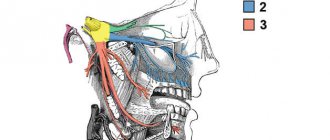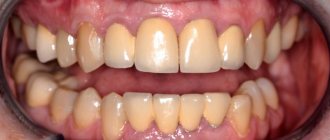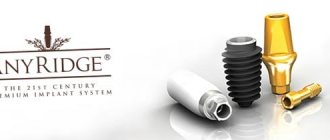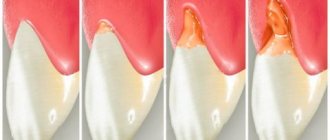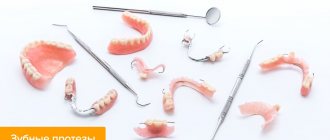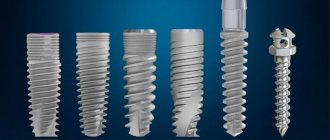In our time, implantology has achieved truly incredible success. Experienced surgeons are able to implant, at a time, not only one tooth root, but an entire row of teeth. Of course, such operations require highly qualified dentists. However, sometimes negative consequences occur after operations, and even during the operations themselves. Less commonly, they occur several years after the seemingly successful implantation of implants into the jawbone. For each such case there are reasons. In this article we will tell you about them.
Why might complications occur?
There may be several reasons for complications after implantation of artificial dental roots. Some of them relate to the mistakes of dentists, and some of them relate to the fault of the patients themselves.
Medical errors include the following:
- incorrect choice of implant length;
- overheating of bone tissue at the site of implant installation;
- insufficient disinfection of the patient’s oral cavity;
- incorrect choice of prosthesis design;
- an error in assessing the physiology of the patient’s body in terms of susceptibility to a foreign body;
- use of low-quality titanium implants;
- use of outdated surgical equipment;
- careless installation of the prosthesis on the root.
The following reasons should be attributed to the fault of the patients themselves:
- careless oral hygiene after implantation;
- the patient's inability to give up bad habits;
- eating solid food during the implant healing stage;
- Irregular use of medications recommended by the surgeon.
Average cost of treatment in Moscow
| Service | price, rub. |
| Consultation with specialists: | |
| dentist | 600 |
| periodontist | 740 |
| implantologist | 820 |
| Services for the treatment of complications: | |
| laser therapy of the gum mucosa | 490 |
| periodontal applications in the area of one tooth | 370 |
| removal of dental plaque in the area of one tooth | 180 |
| implantation of osteoconductive material in the area of one tooth | 10900 |
| implantation of a protective membrane | 12900 |
| application of a protective periodontal bandage | 400 |
| implant removal | 6900 |
The cost of treating complications after implant placement varies depending on the severity of the consequences , extent of spread and treatment methods .
Possible mistakes of surgeons
Negative consequences can occur even during careless operation. Let's name a few medical errors that, unfortunately, although rarely, happen.
Sometimes the doctor inadvertently overheats the head of the titanium root. This occurs due to overheating of the bur and hollow in the jaw bone. The reason for this is untimely irrigation of both.
If the doctor begins to tighten the implant screws while the cement is hardening, this ultimately leads to incorrect root installation, since the cement in this case cracks.
If the doctor does not place the head of the implant tightly in the hollow of the jaw bone, there is a risk of inflammation occurring, as bacteria enter the gap. In addition, loose placement of the head can lead to an imbalance of mechanical load on the entire prosthetic structure. This can cause peri-implantitis.
For prosthetics
The final stage of dental implantation involves the installation of dentures. To do this, the doctor:
- removes the gum former;
- installs the abutment (plays the role of an adapter from the intraosseous element to the crown);
- attaches a crown or orthopedic structure created from previously taken impressions of the patient’s jaw.
The orthopedic design must suit the patient taking into account the position of the implants. Errors can result in incomplete adhesion of the prosthetic attachments and abutments, leading to loosening of the implants. Inconsistencies between them lead to incorrect distribution of the load during operation, which also leads to damage to the structure and is fraught with rejection.
The coordinated work of the orthopedist and implantologist during preparation is extremely important.
Features of implantation in the upper jaw
The operation of implanting titanium roots into the upper jaw is always accompanied by considerable difficulties. This is due to the difficulty of access to the implant installation site and the close location of other organs. Often such operations are accompanied by complications. To make matters worse, the density of the maxillary tissue is lower than that of the mandibular bone. Because of this, it is necessary to drill a deep hole in the bone and install long implants. This can also cause postoperative complications.
During installation of the implant, the nasopalatine bundle, which is located in the center of the upper jaw behind the front teeth, may be injured. Such an injury causes prolonged bleeding, and this leads to the fact that the implant does not take root at all.
There is also a risk of damage to the sinuses and even nasal cavities. In both cases, sad complications are inevitable.
In case of damage to the neurovascular bundles located in the canine area, numbness of the upper lip occurs.
Dentistry knows cases where during implantation the integrity of the sinus floor was violated. This phenomenon leads to the occurrence of sinusitis.
There is also a risk of damage to the palatal artery, causing heavy bleeding.
All of the above may not happen if implantation is performed by experienced surgeons.
Implantation in the lower jaw
Installing artificial roots in the lower jaw is much easier. However, there are certain problems here too, since there are areas on the lower jaw that should never be disturbed.
If during the operation the surgeon disturbs the mandibular branch of the trigeminal nerve, then the patient’s oral cavity will completely lose sensitivity.
If the wall of the mandibular canal is damaged, numbness of the lower lip and part of the chin occurs.
Injury to the external branch of the facial artery generally leads to severe bleeding, and here one cannot do without the help of a surgeon.
Early complications
In the first days after implantation, the patient may experience pain, sometimes very severe. Often, the dentist even prescribes painkillers to patients, which should never be abused. If the pain does not disappear after a week, this indicates that there is inflammation or nerve damage.
About two hours after implantation, swelling occurs in the patient’s mouth, and this is quite normal. It may not go away for a week. At this time, it is allowed to apply ice to the swollen areas. If after a week the swelling has not subsided, then most likely there is tissue inflammation.
The patient's gums may bleed slightly for two to three days after surgery. Blood oozes at the site of the implanted root. If the bleeding is significant, the cause may be poor blood clotting or high blood pressure. If the bleeding continues, then most likely the surgeon damaged a blood vessel. This, in turn, can cause a hematoma to appear at the implant site. Because of this, postoperative sutures may come apart and the wound may begin to rot.
During the first week after implantation, the patient experiences an elevated body temperature. This is quite normal if the temperature does not exceed 37.5 degrees. If it is higher or does not subside after a week, this means that an inflammatory focus has formed in the oral cavity. This phenomenon is usually accompanied by swelling.
There are cases where in the very first days after surgery, patients’ sutures came apart. This happens due to their careless application, due to mechanical damage from solid food, or due to the onset of inflammation.
If within five hours after the operation there is numbness of the tissues near the oral cavity, then you should not be afraid of this, because the anesthesia has not yet completely worn off. If the numbness continues to persist, then the nerve may have been damaged during implantation.
Myth 1. “It hurts.”
Anesthesia reduces pain and discomfort during implant installation to almost zero. It is introduced in stages, before performing the manipulations the doctor will make sure that the desired area is insensitive. Installing an implant is a quick procedure; the freezing will not have time to go away.
If an impressionable person sits in the implantologist’s chair, it is difficult for him to bear the sight of blood, the sounds of implants being implanted into the bone, etc., but we are not talking about severe pain.
In some clinical cases, the patient is put into deep medicated sleep, relieving pain and fear.
Irina Fedenko, Moscow
“When I came for a consultation about dental implantation, I was very interested in the question of how painful it was. The doctor asked me what dental procedures I had had in my life. I answered that I naturally treated caries, about 10 years ago I had an unerupted wisdom tooth removed, and they also removed a cyst on the root of the tooth - the tooth itself was saved. Then they told me that problematic tooth extraction and tooth-preserving surgery are more invasive procedures compared to implantation. Therefore, this time there will be less discomfort. Now having experience, I can say that implantation is only scary psychologically, there is no severe physical pain. Although after the operation I naturally suffered for a couple of days. The cheek was swollen, the eye was swollen, the stitches itched and throbbed. But it’s not scary anymore.”
Late complications
Such complications can arise a year after the successful implantation of artificial roots and the installation of prostheses on them.
Peri-implantitis. Sometimes patients develop peri-implantitis after a year. In simple terms, this is inflammation of the bone tissue near the implant. Most often, the cause of its appearance is careless oral hygiene. Less commonly, the reason is a violation of the implant installation technology. In particular, there are known cases of damage to the gingival cuff and even the presence of cement in it.
It is possible to cure peri-implantitis with medication only at an early stage of its development. In this case, in any case, it is necessary to remove the prosthesis from the root and laser or ultrasonic cleaning of the implant itself. If tartar has formed in the oral cavity, then they must also be removed. Only after this are medications prescribed.
At a later stage of development of peri-implantitis, treatment is much more difficult. It is a complex of surgical and medical procedures. These include:
- ultrasonic sanitation of the oral cavity and gum pockets;
- opening the purulent focus and cleansing the tissue underneath;
- thorough disinfection of the implant;
- removal of dead tissue;
- prescribing a course of drug treatment.
The advanced stage of peri-implantitis cannot be treated. At this stage, the implant becomes mobile. In this case, it has to be removed from the jawbone. A new implant can be installed only after peri-implantitis is completely cured. Unfortunately, this is by no means a simple matter. Only 6 months after the cure of peri-implantitis is osteoplasty allowed, without which re-implantation of the titanium root in the same place is impossible.
Sinusitis. This complication manifests itself in the form of inflammation of the oral mucosa near the maxillary sinus. The treatment process does not require removal of the implant. Usually the problem is solved with drug treatment.
Mechanical damage. Complications due to mechanical damage arise solely through the fault of the patient when, in violation of the doctor’s recommendations, he became interested in eating too much solid food. In addition, mechanical damage to the structure can occur from malocclusion or bruxism. There are known cases where prostheses and even implants broke in such cases. It doesn't matter if the prosthesis breaks. It can be easily replaced. If the implant breaks, then its removal from the jawbone is required.
Question answer:
I don’t have enough bone tissue, they suggested basal implantation. What complications are possible?
Basal implantation is a branch of surgical dentistry, which involves restoring the dentition without replenishing bone tissue deficiency. Implants are installed even if there is a lack of cancellous bone. This reduces the number of necessary surgical procedures and shortens the treatment time, but the method is not confirmed by positive results of long-term data and has many disadvantages: traumatism - elongated titanium rods are used, which are installed in the deep layers of the jaw bone; difficult rehabilitation - long, accompanied by swelling and pain; used when 3 or more teeth are lost - implants are installed at an angle and can damage the roots of adjacent teeth; the service life of implants has not been confirmed; the 2-year rejection rate is about 40%; rejection occurs with exfoliation of bone tissue; low aesthetic result - it is impossible to make dentures that look like natural teeth; limits the possibilities of prosthetics using other methods.
Levin Dmitry Valerievich
Maxillofacial surgeon, chief physician of the Center
Non-survival of the implant
The phenomenon of implant rejection by bone tissue is extremely rare. There is only one way out of the situation - removal of the implants.
Implant rejection does not occur instantly, but in a certain sequence. Each stage of this phenomenon is accompanied by its own symptoms.
At the first stage of rejection, tissue inflammation occurs near the implant. This is followed by an enlargement of the pocket and thinning of the bone in the area of the implant.
In the second stage, the height of the jawbone around the implant noticeably decreases. At the same time, gum detachment occurs until the abutment is exposed. The implant becomes mobile.
The third and final stage is characterized by destruction of the alveolar process and rejection of the implant itself.
The beginning of the implant rejection process can be determined by the following signs:
- swelling of the gums in the area of the implant and next to it;
- general malaise;
- the appearance of pus in the oral cavity;
- the appearance of bleeding from the gums;
- enlargement of the gum pocket;
- implant mobility;
- increase in body temperature.
Problems during the second surgical stage
The second stage of dental implantation involves:
- opening the implant (to do this, the doctor cuts the gum above it);
- removing the plug;
- installation of a gum former.
Due to disorders of bone regeneration, the intraosseous element is twisted, and when implanting teeth in the upper jaw, it is pushed into the maxillary sinus. This complication is prevented at the stage of formation of bone tissue around the implant - during the period of osseointegration, CT is periodically performed to monitor the formation of bone structures.
There are opposite situations when the top of the implant is overgrown with bone tissue. This process is not considered a complication and does not have a special impact on the implantation process. The doctor cuts the periosteum and removes excess with a saw to properly install the healing abutment.
Safe complications
Even after an impeccably performed implantation, natural complications always occur, which are the body’s natural reaction to mechanical intervention. We list the complications that you do not need to be afraid of:
- body temperature up to 37.5 degrees;
- swelling of the face;
- feeling of heaviness in the maxillary sinus;
- minor hematomas;
- quite tolerable pain.
All these troubles can only be endured for a week. If they do not disappear further, then, most likely, something went wrong during the implant healing process.
In our Center, implant installation is safe and completely painless
Painful sensations can be considered a complication during installation. But anesthesia is carried out first, the patient should not feel anything. Increased pain is possible, but the discomfort goes away after an additional dose of anesthetic is administered. The patient should not endure the pain; if it intensifies, the doctor must be informed immediately. We offer implantation in medicated sleep under sedation , when the patient is in a relaxed, comfortable state of half-sleep and does not feel any pain.
Levin Dmitry Valerievich
Chief physician, Ph.D.
How can complications be prevented?
Practice shows that by strictly following all doctor’s recommendations, you can significantly reduce the risk of complications. To do this you need:
- regularly take the medications prescribed by the doctor;
- carefully perform oral hygiene;
- quit smoking;
- undergo annual x-ray diagnostics of the oral cavity;
- stop eating solid food;
- strictly adhere to the postoperative diet.

